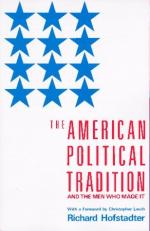
|
| Name: _________________________ | Period: ___________________ |
This test consists of 15 multiple choice questions and 5 short answer questions.
Multiple Choice Questions
1. What did John C. Calhoun wish to preserve?
(a) Slavery.
(b) The South.
(c) The Union.
(d) His wealth.
2. According to Hofstadter, what main problem did free slaves face?
(a) Transportation.
(b) Education.
(c) Voting rights.
(d) Unemployment.
3. What position did John C. Calhoun hold in South Carolina?
(a) Senator.
(b) Governor.
(c) Representative.
(d) Secretary of State.
4. According to the Founders, which group of people should have the most say in the government?
(a) The Congress.
(b) Land owners.
(c) Men over the age of 21.
(d) Legislators.
5. With what political party was Abraham Lincoln associated in Illinois?
(a) The Whigs.
(b) The Progressive Party.
(c) The Democratic-Republicans.
(d) The Federalists.
6. Which political theory is John C. Calhoun attributed with developing?
(a) American Socialist.
(b) Confederate.
(c) Northern.
(d) Corporate capitalist.
7. With what class were most of the Founders associated?
(a) Laborers.
(b) The aristocracy.
(c) The working class.
(d) The middle class.
8. How did Andrew Jackson ensure that his policies would continue to be supported after he left office?
(a) By appointing five Supreme Court justices.
(b) He placed key men in his sucessor's cabinet.
(c) By issuing long-term legislation.
(d) He had the heart of the American people.
9. What did the Founders design the Constitution to protect?
(a) The government from the people.
(b) The laws of the nation.
(c) The nation from outside forces.
(d) Freedom from interference.
10. Why did Abraham Lincoln prefer to read aloud?
(a) To ease his stuttering.
(b) To hone his oratory skills.
(c) To sound out new words.
(d) To hear his inflection.
11. Who won the presidential election in 1828?
(a) John Quincy Adams.
(b) Henry Clay.
(c) Andrew Jackson.
(d) William Crawford.
12. What were Thomas Jefferson's interests?
(a) Psycology and social behavior.
(b) Science and Medicine.
(c) Everything.
(d) Law and politics.
13. Who were the Southwesterners?
(a) Andrew Jackson's constituents from Kentucky and Tennessee.
(b) One of Andrew Jackson's military regiments
(c) A group of politicians from Kentucky and Tennessee
(d) A group of investors led by Andrew Jackson.
14. What was Wendell Phillips's main goal?
(a) To end slavery through any means possible.
(b) To end slavery through legal channels.
(c) To protect slaves who had run away from their owners.
(d) To convince people there was a practical end to slavery.
15. What office did Thomas Jefferson hold in Virginia?
(a) Secretary of the Treasury.
(b) Secretary of State.
(c) Secretary of Commerce.
(d) Governor.
Short Answer Questions
1. What type of lifestyle did Thomas Jefferson promote?
2. What was the Emancipation Proclamation?
3. What did the Emancipation Proclamation not prohibit?
4. What did the Founders believe about man?
5. How does Hofstadter describe Wendell Phillips's political affiliation?
|
This section contains 473 words (approx. 2 pages at 300 words per page) |

|




